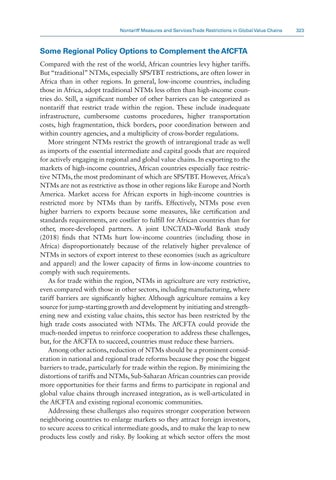Nontariff Measures and Services Trade Restrictions in Global Value Chains 323
Some Regional Policy Options to Complement the AfCFTA Compared with the rest of the world, African countries levy higher tariffs. But “traditional” NTMs, especially SPS/TBT restrictions, are often lower in Africa than in other regions. In general, low-income countries, including those in Africa, adopt traditional NTMs less often than high-income countries do. Still, a significant number of other barriers can be categorized as nontariff that restrict trade within the region. These include inadequate infrastructure, cumbersome customs procedures, higher transportation costs, high fragmentation, thick borders, poor coordination between and within country agencies, and a multiplicity of cross-border regulations. More stringent NTMs restrict the growth of intraregional trade as well as imports of the essential intermediate and capital goods that are required for actively engaging in regional and global value chains. In exporting to the markets of high-income countries, African countries especially face restrictive NTMs, the most predominant of which are SPS/TBT. However, Africa’s NTMs are not as restrictive as those in other regions like Europe and North America. Market access for African exports in high-income countries is restricted more by NTMs than by tariffs. Effectively, NTMs pose even higher barriers to exports because some measures, like certification and standards requirements, are costlier to fulfill for African countries than for other, more-developed partners. A joint UNCTAD–World Bank study (2018) finds that NTMs hurt low-income countries (including those in Africa) disproportionately because of the relatively higher prevalence of NTMs in sectors of export interest to these economies (such as agriculture and apparel) and the lower capacity of firms in low-income countries to comply with such requirements. As for trade within the region, NTMs in agriculture are very restrictive, even compared with those in other sectors, including manufacturing, where tariff barriers are significantly higher. Although agriculture remains a key source for jump-starting growth and development by initiating and strengthening new and existing value chains, this sector has been restricted by the high trade costs associated with NTMs. The AfCFTA could provide the much-needed impetus to reinforce cooperation to address these challenges, but, for the AfCFTA to succeed, countries must reduce these barriers. Among other actions, reduction of NTMs should be a prominent consideration in national and regional trade reforms because they pose the biggest barriers to trade, particularly for trade within the region. By minimizing the distortions of tariffs and NTMs, Sub-Saharan African countries can provide more opportunities for their farms and firms to participate in regional and global value chains through increased integration, as is well-articulated in the AfCFTA and existing regional economic communities. Addressing these challenges also requires stronger cooperation between neighboring countries to enlarge markets so they attract foreign investors, to secure access to critical intermediate goods, and to make the leap to new products less costly and risky. By looking at which sector offers the most


